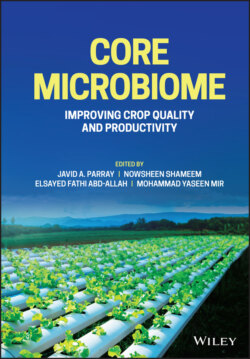Читать книгу Core Microbiome - Группа авторов - Страница 9
1.2 Antimicrobial Properties of Medicinal Plants with Particular Reference to Neem (Azadirachtaindica)
ОглавлениеThere are many reports on conventional medicinal plants and natural products to treat several diseases. Many plant-based medicines utilized in traditional therapeutic systems as agents in the treatment of infectious diseases are recorded in pharmacopoeia, a variety of which have been investigated recently for their efficiency against disease-causing microorganisms. The general antimicrobial activities of medicinal plants and their products, such as essential oils, were analyzed earlier [3,4].
Moreover, medicinal plants also can play an elementary function against rising antibiotic resistance both directly for their antimicrobial activities (e.g., antibacterial, antiviral, antifungal, and antiparasitic ones) and indirectly by reducing resistance against antibiotics.
There are numerous medicinal plants with well-known antimicrobial activity, including traditional Chinese or Ayurvedic medicine. Among medicinal plants adopted in experimental studies, a classic example is the Azadirachta indica (Figure 1.1) commonly known as neem, an evergreen tree of the sub-tropics and tropics, indigenous to the Indian subcontinent, with a recognized ethnomedicinal value and significance in agriculture and also in the pharmaceutical industry [5]. Every part of the neem plant, such as leaves, fruits, seeds, bark, and roots, contains compounds with proven antioxidant, anti-inflammatory [6], antidiabetic, antibacterial, antigingivitic, antifungal, anticancer, antiviral, antiulcer, neuroprotective, antipyretic, hepatoprotective, nephroprotective, and wound-healing properties. It possesses incredible potential within the field of medicine, pest management, and environmental protection. Neem may be a natural source of eco-friendly herbal pesticides, insecticides, and agro-based chemicals [7]. The impact of mouthwash containing neem on plaque and gingivitis was analyzed in a clinical study, indicating that it may help maintain mouth hygiene and suggest an enhanced effect on preventing oral diseases since it is both cost-effective and easily accessible [8]. Approximately 400 compounds are isolated from various parts of neem until now, and significant bioactive secondary metabolites and relatively 30 compounds are isolated from endophytes of neem [5]. Endophytic fungi of neem produce a wide range of secondary bioactive metabolites with potential compounds, namely, melanin, antimicrobial, antioxidant, anti-inflammatory, insecticides, nematicides, etc. [5].
Figure 1.1 Medicinally important parts of the Azadirachta indica (neem) tree showing flowers; fruits; twigs; bark and leaves.
Neem imposes a check on microbial growth and, in the breakdown of cell membrane capability, exhibits antimicrobial properties [9]. Neem nanoemulsion displayed antibacterial activity by disturbing the integrity of the bacterial cell membrane against strains of a bacterial pathogen. Different parts of the plant reveal antimicrobial properties against a wide range of pathogenic microbes [10]. Neem extract has shown antimicrobial effects against Streptococcus mutans and S. faecalis [11]. A new vaginal contraceptive, NIM-76, obtained from neem oil, has shown an inhibitory effect on the growth of various pathogenic microorganisms, including fungi, bacteria, and viruses [12]. The antibacterial property of neem seed oil in vitro against 14 strains of pathogenic bacteria has been recently assessed [13].
